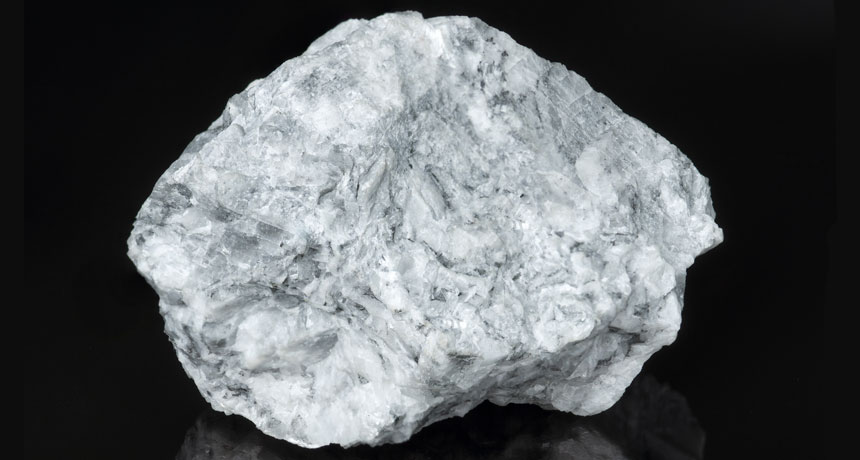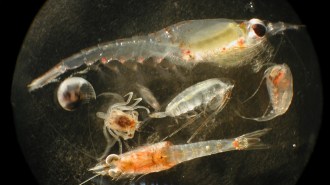Scientists create a mineral in the lab that captures carbon dioxide
A new technique might one day help combat global warming

FAST TRACK It takes thousands of years for this mineral to form naturally. Now researchers have found a way to make magnesite, or magnesium carbonate, in the lab in just a few months.
Aleksandr Pobedimskiy/Shutterstock
- More than 2 years ago
Scientists are one step closer to a long-sought way to store carbon dioxide in rocks.
A new technique speeds up the formation of a mineral called magnesite that, in nature, captures and stores large amounts of the greenhouse gas CO2. And the process can be done at room temperature in the lab, researchers reported August 14 at the Goldschmidt geochemistry conference, held in Boston. If the mineral can be produced in large quantities, the method could one day help fight climate change.
“A lot of carbon on Earth is already stored within carbonate minerals, such as limestone,” says environmental geoscientist Ian Power of Trent University in Peterborough, Canada, who presented the research. “Earth knows how to store carbon naturally and does this over geologic time. But we’re emitting so much CO2 now that Earth can’t keep up.”
Researchers have been seeking ways to boost the planet’s capacity for CO2 storage (SN: 6/5/10, p. 16). One possible technique: Sequester the CO2 gas by converting it to carbonate minerals. Magnesite, or magnesium carbonate, is a stable mineral that can hold a lot of CO2 naturally: A metric ton of magnesite can contain about half a metric ton of the greenhouse gas.
But magnesite isn’t quick to make — at least, not at Earth’s surface. Previous researchers have considered pumping CO2 deep into Earth’s interior, where high temperatures and pressures can speed up the gas’s reaction with a magnesium-bearing upper mantle rock called olivine. But many barriers remain to making this idea commercial, including finding the right locations to insert the CO2 to produce large amounts of magnesite and the costs of transportation and storage for the gas.
Another option is to try to make magnesite in the laboratory — but at room temperature, that can take a very long time. One place where magnesite forms naturally at Earth’s surface is in arid basins called playas in northern British Columbia. From previous work at such sites, Power and his colleagues determined that groundwater circulating through former mantle rocks such as olivine in the region becomes enriched in magnesium and carbonate ions. The ions eventually react to form magnesite, which settles out of the water. In British Columbia, the process began as far back as 11,000 years ago, Power says. “We knew it was slow, but no one had ever measured the rate.”
Under very high temperatures, scientists can quickly create magnesite in the lab, using olivine as a feedstock. But that process uses a lot of energy, Power says, and could be very costly.
The problem with making magnesite quickly, Power’s team found, is that water gets in the way. To make the rock in the lab, Power and colleagues put magnesium ions into water. When the magnesium ions — atoms that have a charge due to a gain or loss of electrons — are put into water to create the magnesite, the water molecules themselves tend to surround the ions. That “shell” of water molecules hinders the magnesium’s ability to bond with carbonate ions to form magnesite. “It’s difficult to strip away those water molecules,” Power says. “That’s one of the reasons why magnesite forms very slowly.”
To get around this problem, Power and his colleagues used thousands of tiny polystyrene microspheres, each about 20 micrometers in diameter, as catalysts to speed up the reaction. The microspheres were coated with carboxyl, molecules with a negative charge that can pull the water molecules away from the magnesium, freeing it up to bond with the carbonate ions. Thanks to these microspheres, Power says, the researchers managed to make magnesite in just about 72 days. Theoretically, he adds, the microspheres would also be reusable, as the spheres weren’t used up by the experiments.
That result doesn’t mean the technique is ready for prime time, Power says. So far, the scientists have made only a very small amount of magnesite in the lab — about a microgram or so. “We’re very far away from upscaling,” or making the technology commercially viable.
“What we’ve shown is that it’s possible to form this at room temperatures,” Powers says. Now, having demonstrated the proof of concept, the team can explore next steps. “We want to better understand some of the fundamental science” involved in magnesite formation, he adds.
“The result really surprised me,” says Patricia Dove, a geochemist at Virginia Tech in Blacksburg. Many questions remain about how cost-effective and energy-efficient the process might be, she says, but it’s “certainly very intriguing.”







